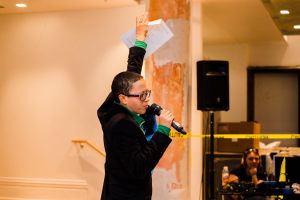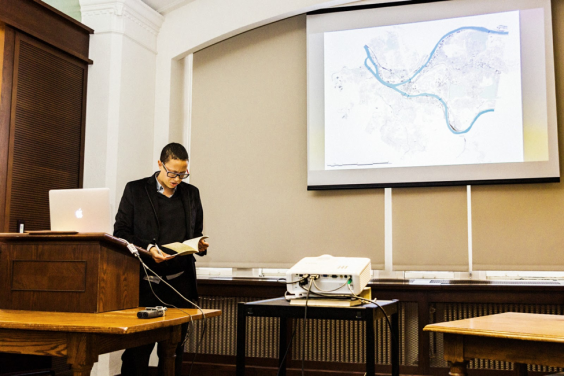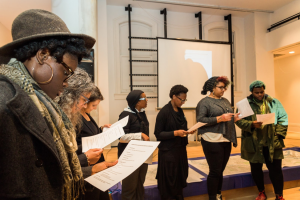Recognizing Hungers That Are Already There: A Conversation with Designer Mitch McEwen
by Leah Wulfman / January 12, 2017 / No comments
In December 2016, the interdisciplinary arts symposium “Why Does Black Art Matter Now?,” organized by the Center for African American Poetry and Poetics (CAAPP) at the University of Pittsburgh, brought a great cast of contemporary Black artists to Pittsburgh, Pennsylvania—visual artist Lorna Simpson, poet Robin Coste Lewis, and architectural designers Mitch McEwen, Imani Day, and Mario Gooden. In countless ways, the symposium addressed a broader now—the forever now—and the set of circumstances that led to the immediate now—”the now now,” as Mitch McEwen referred to it. On the evening of November 30, McEwen, who is also an urban designer, led a community design charette called “This Is What We Will Build When We Get Our Reparations” at City of Asylum. The struggle for America’s recognition of Black America’s humanity is ongoing, with both more to fight for and always more to imagine. Mitch utilized the design charette to engage the City in the topic of reparations and develop visionary spatial propositions for the descendants of enslaved Africans in the United States. The discussion and work presented through the symposium events was celebratory, complex, undistracted, enlightening, matter-of-fact, subversive, transgressive, and so much more. It engaged questions of how we unearth and rewrite history for Black subjectivities and sexualities.
Mitch McEwen is a self-described “roving urbanist” based in Detroit. She works in architectural and urban design, focusing on the intersection of urban culture and global forces. Mitch is Principal of McEwen Studio and Partner of A(n) Office, an emerging design practice based between Detroit and New York City, and is the founder of SUPERFRONT. Before co-founding A(n) Office, she worked as an urban designer in the office of Bernard Tschumi Architects and New York City’s Department of City Planning. Since 2014, she has been Assistant Professor of Architecture at Taubman College of Architecture & Urban Planning, University of Michigan. McEwen’s design research focuses on the use of infrastructural analysis and digital processes in diverse urban situations. Collaborating often with artists, theorists and cultural institutions, Mitch McEwen’s work has included development of portable architectures, collective manifestos, and digital architectural freeware, as well as built work in adaptive reuse and urban design.
Designer Leah Wulfman spoke with Mitch for SampsoniaWay.org in a wide-ranging interview about the social need for progressive architecture in contemporary urban landscapes, and the role of architects in achieving racial and economic justice.
(A)n Office: Evolving Architecture Through Cities and Collaborative Practice
Leah Wulfman: You are a co-founder of the studio collective (A)n Office, which is responsible for projects such as “House Opera,” “Promised Air,” that forwardly engage the social and political aspects of architecture and urban design. The meaning of studio’s title is ambiguous: “The A might stand for Architecture. It might not. It might stand for Anonymous or Art or another word, like Another.” How is this name representative of the working methods of the collective, and what brought your team together?
Mitch McEwen: The biography of A(n) Office is not that of a singular, fixed team. It is set up in a way such that the founding studio members have already fluctuated a couple iterations. So A(n) Office is a meta office, a studio of studios. We started with a lecture in 2013 at the Princeton University School of Architecture, for the Anonymous conference organized by Sylvia Lavin. For this, we had to come up with a name and a strategy. At the time, there were three of us, and later we obtained an office space for a month-long residency in Manhattan. Then there were a different three, and again, with this past year’s Venice Architecture Biennale, “The Architectural Imagination,” there were another three of us. So, it’s an iterative process, but the whole principle of multiplicity as an office structure remains intact. Of course, there’s also the word play with Gordon Matta-Clark’s Anarchitecture (1974)—a combination of “anarchy” and “architecture”—where the “An” becomes a “Without.” So, A(n) Office is an office without an office, or an office with multiple offices.
My individual practice is in Detroit with McEwen Studio. Through this platform, I can work with students in Ann Arbor or communities in Detroit from different disciplines. I’ve been developing work through McEwen Studio since I was granted the architecture fellowship at the Akademie Schloss Solitude in Stuttgart, Germany where I could produce my own work and set my own agenda. SUPERFRONT, an architecture oriented non-profit gallery in Bed-Stuy, Brooklyn, was the first iteration of my individual practice. Over the course of directing SUPERFRONT for three to four years, I collaborated with nearly 150 different individuals and organizations leading to many exhibits. I’ve been iterating on different methods of both having a practice and collaborating. A(n) Office comes out of wanting to have a structure for practice that enables me to have my own work and own agenda, but also collaborate with others on projects. We, as A(n) Office, come together to work on projects that have a more national and international scope.
LW: How has working in Detroit opened up and extended your architecture practice? How has working in that particular space and place and collaboratively with art collectives and residencies changed how you conceive or expand the notion of client?
MM: Detroit is an amazing place to be working. I started going there about five years ago and began working on a house when I had the fellowship in Germany, which then became the “House Opera” project. In coming to Detroit, I had a multiplicity of tactics for developing a flipping houses podcast space for a client to emerge, which I had been working on in New York City. The fields of architecture and urban planning are so consistently racist, hegemonic, and only interested in luxury or white America. One of the side effects of this is that those who are not participating in that world of luxury or existing in public space that’s already been certified as white enough, they simply don’t even relate to architecture as a potential client-service relationship. They take on architectural work themselves because no one else is there for them.
So, in Bed-Stuy, Brooklyn with SUPERFRONT, I designed temporary projects for the neighbors. I had numerous tactics for inventing the client, and now, being in Detroit, the wonderful thing is that the client no longer needs to be invented. The client is emerging from amazing work being done by and with the people of Detroit and City Planning. It’s incredible to have people who are working with the built environment and have an agenda that is simply more equitable.

“This is What We Will Build When We Get Our Reparations”: Community Workshop with Mitch McEwen. Photo by Heather Kresge.
LW: You are opening up and engaging architecture outside of the discipline’s established protocols and rarefied means of practice. How do you reach out to individuals and communities that aren’t typically reached with traditional architecture practice and working methodologies? How is your engagement with open source architectural platforms and parametrics a part of this agenda?
MM: I actually am a bit skeptical about working directly with a community. We are trained to operate in a disciplinary way; there’s a techne. So, I’m skeptical of the pretense that we can walk into a room with people that have never done any architecture or urban planning and immediately have everybody get to work. The “This Is What We Will Build When We Get Our Reparations” charette that I conducted at the City of Asylum was somewhat of a critique of the standard charette, and it was a prototype that I will continue to iterate on and re-present. It can never be a final thing, no final vision.
As I see it, for anything in public space, you have to invent the public.
That’s different from open source since open source is within the techne of the discipline. If you have alternative methods of sharing data or working with geometry, then that’s a means of circulation amongst people within the discipline, rather than attempting to patent and make these new methodologies part of the traditional office model. This type of work is evolving through A(n) Office, where we are investigating how we can come up with new models for securing revenue and payment that aligns with what we are aiming to do in society. It’s not a finished thing. It’s not an answer.
Teaching as an Assistant Professor at the Taubman College of Architecture and Urban Planning also enables my practice to be accessible and successful. I don’t solely need my practice to pay the bills, meaning that I don’t have to work renovating rich people’s kitchens. Connecting with an educational institution is generally what is required if you want to start your own experimental practice in the USA. In other countries, it is much easier to go out on your own and find other means to get selected to do projects. There are some countries that support architecture.
LW: Yes, and this is what is so fantastic about the architecture exhibition currently on in the Heinz Architectural Center in the Carnegie Museum. Building Optimism: Public Space in South America showcases both emerging and world-famous architects designing and utilizing public space directly to promote positive change. It includes beautiful films documenting Lina Bo Bardi‘s SESC Pompéia project in São Paulo, Brazil. So, it’s immense to see the support for public architecture in South America, versus here where the idea and reality of a truly public architecture is severely lacking. In the United States, public spaces now tend to be a built-in commodity—encouraged as a token—to completely private projects.
So regarding your charette at City of Asylum, one of the most significant aspects of the charette for me was the beginning, when you invited all the reparation-deserving individuals to the front of the stage and handed them a list of instructions to disperse and discuss back amongst the individual table groups. This turned the room around completely, as these individuals were suddenly the immediate, central leaders for each group. You mentioned earlier that you are working on various iterations of the charette. Were there any working methods you were referencing and replicating with the charette?
MM: No, I actually came up with that initial step on the spot. As I see it, for anything in public space, you have to invent the public. So when you are proposing a new subway line in New York City—when you have a major infrastructure project that is going to cost billions of dollars, when you have some degree of public engagement, when you say you are going to talk with the New York City public and see what they want—if everyone that shows up is from Indiana, you are going to say, “I’m sorry, but why are you here? Why are you here in this room? How is this about you and for you?” Generally these conversations are structured geographically to align with the public. Even though the money is federal, so technically Indiana dollars and Missouri dollars going in a New York subway line, you don’t go to Indiana. You are going to talk with people in Manhattan, Brooklyn, and Queens.
So when the charette is called, “This Is What We Will Build When We Get Our Reparations,” I simply assume that the majority of the people in the room would be showing up to say, “When are we getting our reparations?” When I saw that this was not the case, I had to quickly figure out how to take advantage of the steps I had already drawn up in order to make sure that those who identified as getting reparations would be the ones leading the group. This is an example of what we always do as architects and urban planners. We never say because we are designing a subway in Manhattan with federal dollars, we are going to Missouri to discuss. We always make decisions based on what is at stake for whom.
Urban planning had to have a mea culpa of sorts after the ‘60s and slum clearance, when it was painfully obvious that planning had been enmeshed in supporting the White Flight of the ‘70s—in subsidizing the white suburbs through the erasure of Black neighborhoods. Black neighborhoods were used to capitalize and then pay for these very expensive projects in cities.
Continue reading this article on page 2






